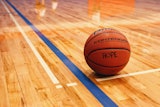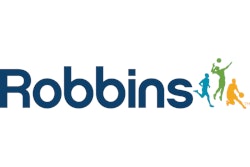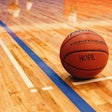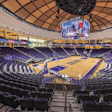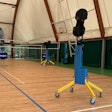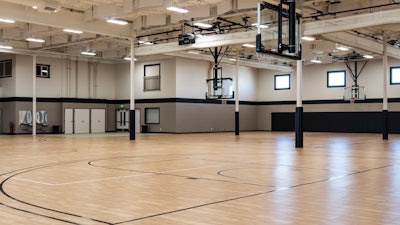
Can you imagine the injury rate among athletes if all gymnasium sports were played on concrete? In fact, they are, but it’s what flooring manufacturers put between the concrete substrate of a gymnasium and the athlete that allows for safe and consistent competition in basketball and volleyball — the two predominant gym sports — and other indoor activity.
Considering that merely running on a surface exerts a force up to eight times the runner’s body weight on their calf muscles and up to 14 times on their bones and joints, no flooring can eliminate injury risk altogether. Still, manufacturers are constantly seeking new technologies to bring the safest surfaces to the sports market, while also ensuring high performance.
“Safety in every realm of the business is important, whether it’s for an NBA player or for a child who’s in first grade,” says Kevin Price, a regional sales manager at Robbins Sports Surfaces who also handles the company’s relations with the NBA. (Robbins floors are used by half the league’s teams.) “If they’re playing on hard surfaces, slowly but surely over time, it’s going to disrupt their growth, it’s going to disrupt what’s happening to their body. We’re trying to protect the athletes — from as little as first grade all the way up to the NBA.”
Here’s a look at some of the most common forms of gym flooring and what makes them a safe choice:
 Photo courtesy of Robbins Sports Surfaces
Photo courtesy of Robbins Sports Surfaces
Hardwood
Northern-grown maple makes up the vast majority of hardwood sports floors, be they wall to wall in a permanent elementary school installation or regularly pieced together in a professional arena that alternates between NBA basketball and NHL hockey.
“It’s more flexible,” Don Brown, technical director at Action Floor Systems, says of the maple itself. “It doesn’t splinter or crack as easily as some other flooring, so it’s not as brittle as some floors. And it’s very hard, so it takes the abuse of gym floors that have a lot of activities going on — bleachers, concerts, chairs, tables.”
Hard but flexible makes wood floors a preferred choice at all levels of competition — and a safe one, according to Action, which has expanded its testing of floors to improve the mitigation of head impact injuries in addition to the much more typical lower extremity ailments that plague basketball and volleyball players. In fact, Brown would recommend wood over synthetic flooring alternatives in terms of head-impact safety, even as Action offers both. “It sounds counterintuitive, but we would probably pitch the wood floor as safer for head impact,” he says. “There’s more resiliency in the wood floor, as far as how far that floor moves vertically up and down. It’s more of a cushion for somebody who might fall. It actually absorbs the energy better, because the surface moves farther in a wood floor than a synthetic floor.”
For starters, the profile of a maple floor — which, depending on the manufacturer may be backed by one of dozens of different subfloor options — stands thicker than most synthetics. “Your synthetic floors, if they’re only a half-inch thick, can only compress half of that when you impact it. That’s only a quarter of an inch of depth that that impact can go, and that makes it very hard. That’s why the wood floor in terms of safety and head impact injuries is better,” Brown says, pointing out that a wood floor separates the athlete from the concrete by up to 2.75 inches. “When we talk safety, we’re talking Head Impact Criteria. Because the floor flexes, it’s actually like a cradle, and it captures the impact and lets the floor bend more, so the impact isn’t as extreme.”
Wood floors are tested on five specific dynamics: shock absorption, vertical deflection, area deflection, ball rebound and surface friction.
“The first and probably most important is shock absorption, which is how much energy the floor will absorb from the athlete,” says Brown, noting that widely used testing incorporates a sensor-laden “artificial athlete” to collect data. (Action is currently partnering with Northern Michigan University to gather additional data from random human athletes using a blind study in which four different subfloors with different shock-absorption characteristics are tested.)
 Photo courtesy of Pinnacle Sports Group
Photo courtesy of Pinnacle Sports Group
“We look at what happens to the athlete when they impact our floor,” says Price at Robbins. “When you think of a crash test dummy, they’re driving a car into a wall and the car gets smashed, but they aren’t testing the car. They test the dummy drivers to see, ‘Okay, how did that affect them and how do we protect them?’ We’re trying to do the same concept with sports flooring.”
Vertical deflection is “a fancy term for how far the floor moves up and down,” Brown says. According to Price, industry standards dictate that a floor vertically deflect a minimum of 2.3 millimeters.
“Then there’s area deflection, and that’s kind of like how you see a trampoline move when you jump up and down,” Brown says. “You have the impact point and then how far out the floor system moves beyond that point of impact, kind of like a circle.” Adds Price, “I’m 235 pounds, and if I’m going up for a rebound against an athlete who’s 180 pounds, we don’t want them falling into my trough, so for area deflection you go out 20 inches from the point of impact, and that floor has to deflect less than 15 percent.”
Ball rebound is really a basketball-specific concern, since dribbling is an integral part of the game, whereas the whole point of volleyball is to keep the ball from hitting the court. Surface friction is important to both sports, given that footwear used to play each is very similar, but it comes into play from an injury standpoint in volleyball, where players are hitting the deck with greater frequency.
The trick is to create a floor that’s responsive to the activity of a sport, including the movements of participants and the bounce of the ball, while simultaneously easy on the athletes’ bodies. “It most definitely is a balance, and we’re fortunate enough at Action to use an all-natural rubber, which provides great shock absorption, but keeps the ball rebound quite high, as well,” Brown says, referring to one subfloor component. “Those are our resilient pads, made of all-natural rubber, that are typically attached to the bottom of our subfloor systems.”
Like Action, Robbins adheres to the aforementioned five testing criteria — known as the PUR Standards — endorsed by the Maple Flooring Manufacturers Association.
Price takes it even further. “I think there are three critical aspects,” he says. “Obviously, shock absorption is important — always has been and always will be. Vibration control is important and uniformity is important. And those three combined really make for a premier sports surface.”
“Our top-of-the-line system is called MVP. It stands for Maximum Vibration Protection,” Price adds. “Robbins firmly believes that vibration leads to fatigue, which could potentially lead to injuries. We just feel that the less vibration in the floor, the safer it is for the athlete.”
Karl Borree, director of sales at Action Floor Systems, agrees that a floor’s corner-to-corner uniformity is key when sparing ankles and knees. “You make the surface completely uniform everywhere, so that the subconscious athlete never has to question how to put their foot down,” Borree says. “The floor is the same everywhere.”
 Photo courtesy of Mondo
Photo courtesy of Mondo
Synthetics
Synthetic gym floors take three basic forms: poured-in-place sandwich surfaces, rolled goods and snap-together tiles.
In addition to its wood products, Robbins offers Pulastic®, which involves adhering a rubber pad to the concrete substrate and adding four layers of poured urethane and a painted topcoat for a seamless playing surface. “It’s taking the best attributes of rubber and the best attributes of a poured floor and marrying them into one,” says Price, adding that its safety characteristics can be further enhanced by specifying a higher-performing pad or by installing a wood subfloor before employing the aforementioned pad-plus-layering process. “There are many synthetic surfaces that, when placed over a wood subfloor, really become outstanding, safe-performing floors.”
A good shock-absorption goal is 53 percent of impact, according to Price, citing DIN (Deutches Institut fur Normung) Standards. “Most wood floors that are made now are going to be 45 percent and higher,” he says. “Most synthetics that are out there are going to have less than 45 percent shock absorption, unless you use a ticker pad or a higher-performing pad like we use in our Pro 110 Comfort system. You can definitely get top-of-the-line synthetic surfaces that have 55 percent shock absorption built into them, but they are costly.”
For that reason, Price — like Brown — leans toward recommending wood for safety-conscious clients on a budget. “Right now, with our synthetic systems, there is performance built in at every level, and especially at the highest level. However, I think with wood systems, you can get more value for your dollar, because I think there’s more performance built into a wood floor and at a little bit more of an economical price.”
Economics and applicability are two factors that often drive prospective buyers to rolled and tile floors. “It’s cost, and it’s also the environment that they can flourish in,” says Jake Angrisano, a sales representative at Mateflex, manufacture of polypropylene flooring tiles, including one model — ProGym Plank — with a vinyl insert designed to both resemble wood and add resilience. “Hardwood can’t go in certain places. If you’re putting this in a basement environment or a warehouse that sees water in the area, that would affect the hardwood, make it not effective for that space. Being that our tiles don’t actually include the wood, we can go in places where the wood can’t. Should the space flood, it’s not going to affect the tile. It’s not going to make it swell and become unusable.”
In the interest of enhanced safety, a 3-millimeter foam underlayment can be specified or even doubled-up under the tile. “It’s just floating over the concrete for the most part, but sometimes we do include an underlayment, which can soften the experience for the player,” Angrisano says. “For volleyball, we’ll include that underneath, and that makes it much more comfortable for players who are either diving or falling. For volleyball, you do want a softer surface, so if you do dive, you’re not going into concrete.”
Moreover, Mateflex tiles feature rounded edges that make for smoother seams, thus mitigating skin abrasion risk for sliding athletes.
Another tile manufacturer, SnapSports, introduced ShockTower® technology to the gym flooring marketplace — a “sort of suspension system,” in the words of Adam Drost, founder and CEO of one of SnapSports’ largest distributors, Pinnacle Sports Group. “That’s their proprietary system that works well, and that’s what we’ve seen a lot of facilities lean toward. It’s engineered into the base of the tile, and it just helps increase force reduction.”
Much of SnapSports business is in residential courts, but it’s worth noting that NBA players past and present rely on the flooring in their home training facilities to protect their bodies — be they aging long after retirement like Shaquille O’Neal’s, or still in their physical prime.
“Another patented system that SnapSports has is the TuffShield® coating,” Drost says. “That’s basically a film that’s applied when injection-molding these tiles, and that’s a protective coating that gives a bit of a gloss to it. We see that in a lot of commercial facilities. It’s a bit more durable and easier to maintain, and then it also gives it a glossier finish, like you would see on a traditional suspended hardwood floor with a coating on it.”
The ability to customize surface texture is a hallmark of Mondo sports flooring, but it’s what’s going on beneath the surface that makes the company’s rolled goods a smart choice — both in terms of safety and performance. “When we get to the point of resiliency or safety, a lot of people talk about shock absorption and vertical deflection — how much the surface bends — and we focus more on energy return,” says Mondo vice president Jon Isaacs. “When an athlete impacts the surface, it’s not only how much the surface bends, but then how quickly it returns. And that return of energy is what we believe reduces potential injuries to the athlete.”
Only within the past three years, Mondo began incorporating into their gym flooring the same so-called Cloud technology found in the company’s internationally renowned tracks. “In the undersurface of many of our products, we have our Cloud technology, a disbursement in the underlayment that allows the surface upon impact to flex down, but then spring the energy forward to allow the athlete to get that energy return, that resilience, back into their body, which then also helps them jump higher and spring forward with a longer stride as they’re running back and forth. We learned from our track technology and were able to easily transfer that into the gymnasium to spring-load that floor and allow it to really push those Clouds back up into the athlete.”
Perhaps the greatest examples of Mondo’s rolled good versatility take the form of multisport fieldhouses, where a 300-yard running track might encircle multiple basketball, volleyball, tennis and pickleball courts, all at consistent thickness, but with custom texturization on their specific playing surfaces for ultimate performance and safety. Isaacs echoes Burree when he says, “The importance of uniformity in a surface, we believe, is super critical for any athlete. As they’re impacting the surface, their body is telling them where the surface is upon impact, and if that surface is not uniform throughout, it’s just those little tweaks that create some significant issues. Uniformity is critical.”
No matter the options under consideration, consumers specifying gymnasium flooring should consider both its end-users and potential usage.
Says Burree, “If you know the age of the athlete, the size and maturity level of the athlete, once you have that determined — be it K, elementary through middle school, middle school to high school, high school to college — once you have those parameters set up, you know what athletes need what — softer floor, performance floor. From there, you can look at how the facility’s going to be used, the space. What are they going to do in that space? What’s it for? Then you look at good, better, best, and where does your budget fit within those parameters to get the best value to the customer?
“Elementary school, we’re very much concerned about the softness of the growth plates and that head injury protocol, because their heads are oversized in relation to their bodies at that grade level. In middle school, you have to deal with the most varied weight changes, because you’ll have kids who have maybe not reached puberty yet to what almost seem to be full-grown adults at 14, 15. And then you’ll need a little bit more performance, whereas the performance side isn’t that important when you’re younger. When you get into high school, college, pro, performance is more significant — the quality of performance. That’s where the tightest uniformity with the best ball bounce comes into play. That’s what we’re trying to get to. How do we fine tune the floor and dial it in for the athletes’ exact needs.”














